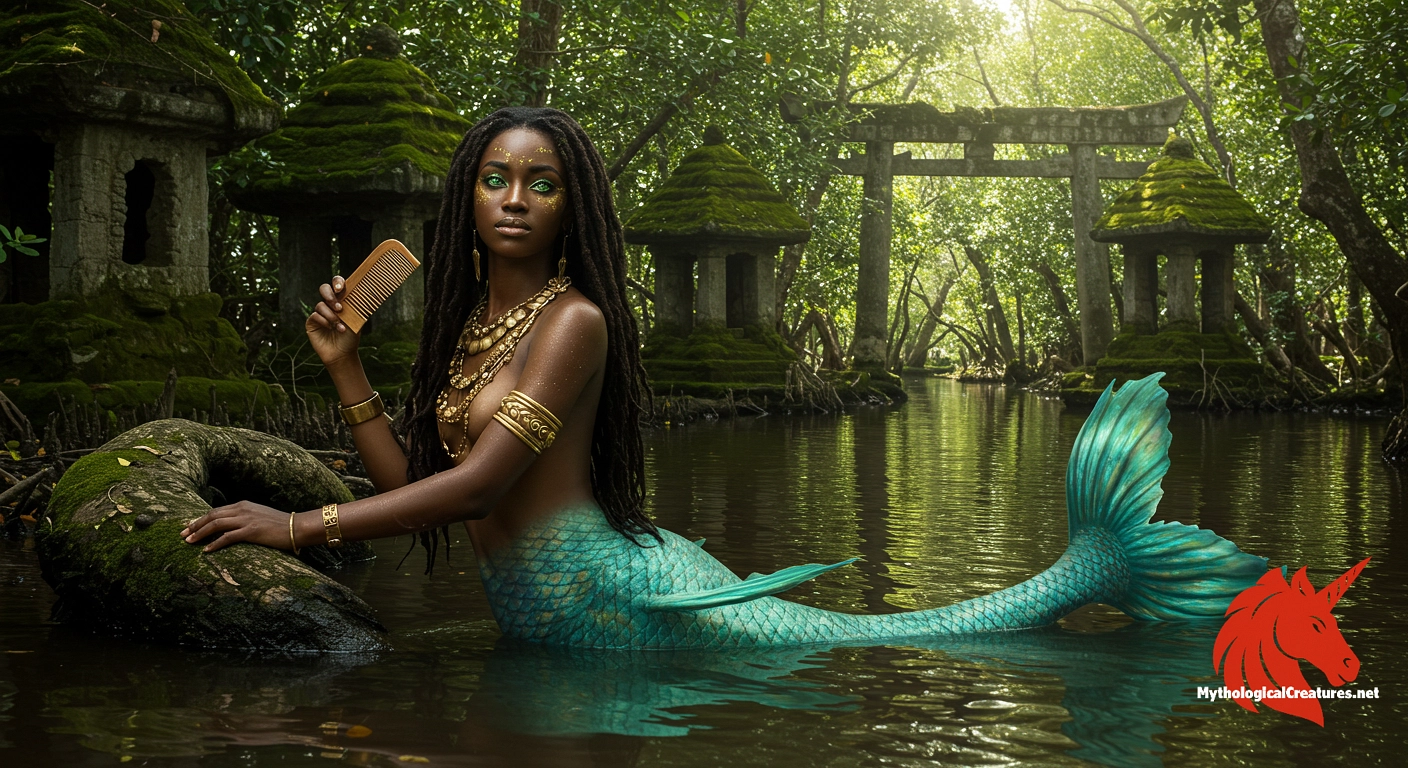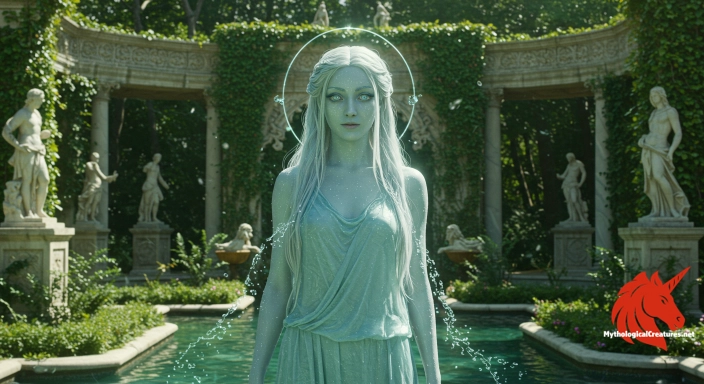Mami Wata: Mami Wata is a captivating water spirit and goddess from African folklore, renowned for her mermaid form and mastery over aquatic realms.

Mami Wata
Mami Wata - Represents the blending of indigenous African beliefs with external cultural influences, symbolizing fertility, transformation, and the mysteries of water.
Origins & First Encounters
Mami Wata captivates the imagination as a potent water spirit whose origins are entwined with early encounters between African and European cultures. She emerges from a fascinating blend of native African maritime lore and the exotic allure of European mermaids encountered by traders centuries ago. Her narrative is rich with the interplay of beauty, mystery, and the transformative power of water, making her a revered yet enigmatic figure in local traditions. Over time, her image has been shaped by the cultural exchanges that have taken place along Africa’s coasts, resulting in a multifaceted identity that transcends simple classifications. Many communities have embraced her as both a benevolent guardian of aquatic realms and a seductress whose allure can bring fortune or peril. Her legends have been woven into the fabric of community rituals and artistic expressions, reflecting a deep respect for the mysteries of nature. The vibrant iconography associated with her mirrors a synthesis of traditional beliefs and the influences of global trade and colonial encounters. In every retelling, Mami Wata embodies the allure of the unknown, inviting communities to explore the delicate balance between life’s gifts and its hazards. Thus, she endures as a symbol of spiritual duality, challenging observers to contemplate the fluid boundaries between divinity and mortality.
Source Texts & Tale Variants
The stories of Mami Wata have been preserved through a diverse array of oral traditions, artistic depictions, and early colonial records. Narratives passed down through generations have allowed her legend to evolve, each variant adding layers to her complex persona. Early European travellers noted vibrant depictions reminiscent of mermaid imagery, blending these observations with indigenous African myth. Many local bards and community elders recounted accounts of a water deity who both blessed and bewitched, ensuring her tale was transmitted with passion and regional nuance. Ancient chants, ritual songs, and symbolic performances have further enriched her myth, making it a living tradition. At times, the tales emphasise her benevolent nature as a giver of wealth and protection, while in other versions, her seductive charm is portrayed as a source of danger. Visual sources such as paintings and carvings from different periods have documented her ever-changing iconography, preserving aspects of both her beauty and her peril. Such rich documentation not only lends credence to her enduring popularity but also highlights the dynamic nature of folklore that evolves with every retelling. These multifarious accounts continue to intrigue audiences and inspire scholarly exploration of her enigmatic presence.
Form & Powers
Mami Wata is often envisioned with a remarkable synthesis of human elegance and aquatic mystique. Her figure is commonly portrayed with a shimmering tail that glistens in a palette of deep oceanic blues, vibrant teals, or lustrous silvers, suggesting a celestial connection to the water. Delicate yet mesmerizing, her facial features are frequently rendered with a soft European allure, complemented by luxuriant, flowing hair that cascades like liquid silk. In many renditions, subtle elements of reptilian grace appear in the form of serpentine accessories or intricate scale patterns along her limbs, hinting at later influences from snake charmer imagery. Her eyes, alight with both seduction and an ancient wisdom, seem to mirror the depths of the sea and the unpredictability of its tides. Attire associated with her is lavish and cosmopolitan, often featuring imported fabrics and elaborate jewellery that underscore her transcultural identity. The size and shape of her form are subject to regional variation, sometimes accentuating a more delicate, mermaid-like silhouette or, alternatively, a robust and commanding presence. Every detail—from the glint of reflected light on her scales to the graceful undulation of her tail—serves as a canvas upon which a multitude of cultural symbols are intricately inscribed. Together, these physical attributes create an image that is both otherworldly and deeply connected to the elemental force of water.
Regional Faces
Across Western, Eastern, and Southern regions of Africa, the depiction of Mami Wata undergoes intriguing local adaptations that reflect the cultural priorities of each community. In West Africa, she is frequently celebrated as a nurturing yet unpredictable water deity whose blessings can bring both abundance and caution. In Eastern Africa, the influence of foreign trade and artistic styles has led to a version that sometimes incorporates motifs reminiscent of neighbouring cultures, thereby enriching her narrative with additional symbolic layers. Southern African interpretations may stress her role as a mediator between the natural and the supernatural, often linking her to themes of fertility and transformation. Local artisans and spiritual practitioners selectively integrate indigenous symbols, resulting in a figure who is continually reshaped by her environment and the beliefs of her devotees. Some regions adhere to the traditional mermaid iconography, while others have embraced the more recent snake charmer influences introduced during the mid-19th century. Communities often build shrines with specific artefacts that resonate with the local understanding of water’s power and mystery. These regional differences highlight the incredible flexibility of Mami Wata’s image, turning her legend into a mirror that reflects diverse cultural landscapes. Ultimately, her beloved presence in various locales underscores her capacity to adapt and serve as a unifying symbol across distinct African traditions.
Cultural Parallels
A careful examination of water deities across various mythological traditions reveals enlightening parallels with Mami Wata’s multifaceted character. Like the European sirens and mermaids, she embodies both the irresistible charm of the unknown and the inherent danger that accompanies such allure. Similar to the river goddesses found in numerous cultures, her dual nature is emblematic of the capacity for both creation and destruction inherent in water. The interplay between seduction and benevolence in her portrayal draws comparisons with other African deities, such as those revered in Yoruba traditions. Her male consort, often known as Papi Wata and sometimes associated with attributes of the Hindu deity Hanuman, further underscores the cross-cultural dialogue present in her narrative. These similarities create a tapestry of shared symbolism that transcends geographical boundaries, demonstrating how water itself is a universal metaphor for life and mystery. Cultural narratives often use these water spirits as a means to convey lessons about the unpredictability of nature, echoing themes of transformation and renewal. In comparing these legends, one finds that Mami Wata not only stands out for her unique attributes but also resonates with a collective human fascination with the elemental power of water.
Legacy & Modern Evolution
The depiction of Mami Wata has seen a remarkable evolution from early maritime lore to modern expressions of art and identity. Initially emerging from the dynamic confluence of European mermaid imagery and African spiritual traditions, her iconography transitioned over time by absorbing influences from snake charmers and even Indian aesthetics. As colonial encounters intensified and global trade expanded, her image became a malleable symbol, capable of adapting to shifting cultural currents. In contemporary society, Mami Wata has been embraced by artists, writers, and musicians who reinterpret her tale as one of empowerment, mystery, and resilience. Modern media, ranging from digital art installations to popular literature, continue to celebrate her as a potent emblem of fluid identity and transformation. Despite occasional challenges from religious institutions that seek to curtail traditional practices, her legacy thrives in festivals, communal rituals, and even urban murals. The metamorphosis of her narrative—reflecting both continuity and change—demonstrates the enduring power of myth. Through each reinterpretation, she remains a dynamic figure at the intersection of tradition and modernity, inviting ongoing dialogue about the deep-seated human connection to the natural world.
Interesting Fact
Mami Wata’s evolution from a mermaid depiction to a complex deity underscores the dynamic interplay of cultural exchange and the transformative power of folklore.
Quick Creature Info
Features:
Associations:
Our Mythic Legendary Rating:

Also Sometimes Known As:
Habitat:
Supernatural Powers:
Physical Attributes:
Abilities:
Behavior:
Lore:
References
Discover Another Mythical Legend You May Not Have Heard Of?
Uncover the mysteries of ancient folklore and expand your knowledge of legendary beings from cultures around the world.
Dare to Meet the Juturna....
Mythical Disclaimer: The images and data on this site are derived from various historical and literary sources, but we have found that many myths often have multiple versions and interpretations across references, sometimes contradictory. As a result, these creature depictions are artistic interpretations—imaginative blends of folklore, legend, and a dash of AI guesswork. Because creature descriptions vary widely, our illustrations and accompanying information represent our best effort to honor mythology while bridging creative gaps. Enjoy these interpretations—just remember, we've done our best to respect the stories and validate available data, but in the realm of mythology, details often shift, imagination leads the way, and nothing is ever set in stone!
Curated by the Mythological Creatures Team (rev. May 2025)
